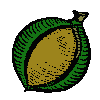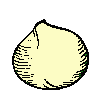About Macadamias
Introduction
Not everybody is familiar with macadamias, so the following are some answers to common questions. Follow the links to get the long answers.
- What are Macadamias? - The world’s premium eating nut.
- Where do they come from? - Originally a native of Australia, but now grown all over the world.
- What can you do with them? - Uses, Recipes and Nutritional info.
- How do you grow macadamias at home? - Planting and maintenance
- How do you crack the dang things at home? - and other practical matters.
What are Macadamias?
Although not well known in all countries, Macadamias are widely regarded as one of the world’s best eating nuts. Macadamias have a subtle nutty flavour and a unique smooth but crunchy texture.



There are two edible species that are sometimes hybridized
M. Integrifolia
Characterized by smooth leaves in whorls of three, pale green new leaves, short creamy white racemes, and a smooth shelled nut. These are preferred for commercial cultivation because the kernel has better processing properties.
They are probably also best for home gardens because they do not have prickly leaves, however M. tetraphylla below have more attractive flowers.
M. Tetraphylla
Characterized by prickly leaves in whorls of four, red new leaves, long pink or cream racemes, and a rough shelled nut. The kernel is also slightly sweeter, but easier to burn when cooked.
Hybrids
A number of varieties are M. Integrifolia x Tetraphylla hybrids gaining vigour and combining characters of the two pure species. For example our garden variety G6 has the smooth leaves of intergifolia combined with the long pink flowers of tetraphylla.
There are several non edible species as well, including M. ternifolia, M. praealta, M. wickhamii.
Back to Top
Where do Macadamias come from?
Macadamias are native only to the subtropical rainforests on the East Coast of Australia. Aboriginal Australians had known of them by a number of names such as “Kindal Kindal”, and used them as a part of their diets for many thousands of years, before they were found by the explorer Alan Cunningham in 1828. The genus was named by Ferdinand Von Mueller and Walter Hill in the 1850s after Dr John MacAdam, a prominent scientist of the time. The oldest known (to this author) cultivated macadamia is in the Brisbane botanical gardens, and was planted by Walter Hill in 1858.
The two edible species M. integriflolia and M. tetraphylla are found in rainforest pockets of South-East Queensland and Northern Rivers of New South Wales. Several non edible species extend the range to Coastal North Queensland.
The first orchards were planted in both Australia and Hawaii in the 1880s, but while there was some activity in the 1940s and 1950s it was not until the 1960s that large scale orchards were planted in Australia. By contrast, the Hawaiians recognized the commercial potential in the 1930s and for this reason it is often assumed that Macadamias originate from Hawaii.
World wide, they are now grown in many parts of the world including Australia, Hawaii, California, New Zealand, South Africa, Malawi, Kenya, Costa Rica, Guatemala, Brazil, Thailand and China. They have become a significant horticultural crop in many of these countries, but there is considerable potential for further expansion of the industry. The approx. 30,000 tonnes of kernel produced world wide represents only about 2-3% of all tree nuts sold.
Back to Top
Uses, Recipes and Nutritional Information
Macadamias can be used in many ways including
- Snack food - either Raw or Roasted Salted, Macadamias are available in many supermarkets in a variety of packages. It is best to buy sealed packets rather than from open trays to ensure that they are fresh. Provided the right packaging materials are used and properly sealed, they can remain fresh for up to twelve months, but they can start to degrade in less than a month if left in the open.
- Confectionery - in chocolate and candy, there is now a huge variety of Macadamia confectionery available. Generally those using half or whole kernels and pure chocolate are best, even if they are a little bit more expensive.
- Baking - excellent in cakes, biscuits, and shortbreads. When baking with Macadamias it is best to use Raw Kernels and low oven temperatures, because they are easy to burn.
- Cooking - enhance the flavour of many dishes from fish to pumpkin soup to salads.
- Oil - an excellent quality oil that is high in mono-unsaturated fats (the good ones). This can be used as a cooking oil, or as the base for salad dressings and add a distinct nutty flavour to dishes.
Recipes & Nutritional Info Macadamia Florentines!
Back to Top
Growing macadamias at home.
If you live in a subtropical environment, you should be able to easily grow macadamias at home. Many residents in Brisbane, Qld have one in their back yards.
Buying and Planting
If you wish to grow them at home, it is best to plant them in the Spring. Buy a grafted tree or cutting from a good quality nursery - they should be able to tell which variety will do well in your area.
After purchasing a good quality tree, don’t make the mistake of putting a $10 tree in a $1 hole. Dig up a volume at least four times the volume of the pot, so the tree has good soft ground for the roots to grow freely in all directions - unlike many trees macadamias are surface rooted and do not have a normal tap root. Plant the tree with a small amount of slow release fertilizer such as Osmocote. Water it in with a bucket of water. If the tree seems a bit floppy, stake it and/or cut the head back a bit.
Ongoing Maintenance
Keep a bed of mulch around the base of the tree, and in the first three months give the tree a bucket of water once a fortnight or more if conditions are dry. Give the tree a light dressing of mixed fertilizer each Spring - then sit back and wait. It should start bearing nuts in five to eight years.
The major pest that is likely to do the most damage in back yards is the flower eating caterpillar. It is not really recommended that you spray for this pest. A medium size tree could have 5000 racemes each with 200-400 florets. You only need 100 of these florets to set for each kilo of crop.
The only pruning you need do is to keep lower limbs from lying on the the ground. Just cut these off at the trunk. Also cut out any dead or dying limbs.
Keeping trees small
Trees can be kept to any size within reason whilst remaining productive simply by hand pruning each winter. Do not go down the topiary path, if you trim with a hedge pruner it will just encourage more canopy growth. Rather just scope out any branches that are outside your desired envelope then follow them down to a fork and cut them out there. It doesn’t really matter where the fork is, it can be near the outside of the canopy or right down to the trunk, the tree will compensate in due course.
Harvesting
The easiest way to harvest your crop is to wait for it to fall naturally. Pick them up about once a week, take of the outer husks and store them in a cool dry situation. More on this in the next section.
Back to Top
Cracking macadamias at home
One of the questions we are often asked about macadamias is “How do you crack the dang things?”. The macadamia shell is so hard that using a normal nut cracker either break the cracker or your patience. But fortunately there are several ways to crack them in the home. But before going in to cracking, it is probably a good idea to look at drying first.
Drying Macadamias at Home
When freshly fallen from the tree, the nuts have a high moisture content. Some people like to eat nuts like this (they are a bit like coconut in texture, with a creamy flavour), but if you want to keep them any period of time they should be dried. Also when they are wet the kernel sticks to shell and can be difficult to remove. Nuts that you purchase from a shop should at least partially dried and ready to crack.
To dry freshly picked nuts you can start by storing them in a dry area, no more than 50mm (2 in) deep in baskets that let air flow past them. It will take a two to four of weeks, depending on the weather, after which you should be able to hear them rattle when you shake them - which means the kernels have separated from the shells so they are much easier to crack.
You can speed up the process by applying a little heat, but it is very important that do not allow the temperature to go over 35C (95F) in these early stages. One way to do this is to place a couple of light bulbs under the baskets to warm the air, or you can put the basket over the warm air rising from the back of a refrigerator.
The kernels of nuts dried in this manner will still be quite soft. The nuts are easy to crack and the kernels perfectly good to eat, but if you want to cook with them, roast them, or store them for long periods, they will need further drying.
Cracking Macadamias at Home
!! Always wear eye protection when cracking macadamias at home !!
Option 1: The sore thumb method
Well, the simplest cracker is a hammer. The problem with this is holding them down. You can try to hold them between your fingers on some concrete, brick, paving etc., but it’s best to send the kids off first - because the language can get a little ‘blue’ after you hit you thumb for the third time ;-)
You can add a level of sophistication to this system by spending half an hour to chip a little well into the concrete for the nuts to sit in. Then you can hit them with the hammer ‘hands free’, and as long as you put your cracking station in a nice part of the garden it really can be quite an enjoyable task. With a little practice you can get quite a high percentage of undamaged nuts.Option 2: The vice method
Another way of cracking them is to crush them in a fitter’s or carpenter’s vice one by one. This is a little slower but much safer than the hammer method, and usually gives more whole kernels. You can also use a pair of vice grip pliers, with one of the jaws ground to a blade. Place the blade along the suture line of the shell for best results.Option 3: Commercial Hand Crackers
There are various simple hand crackers available (basically portable versions of Options 1 & 2), that usually retail for less than $20. In my view the vice ones are best, even if they are a little slow. Some modify the principle and use a blade instead of an anvil.
If you live in an area where macadamias are grown or well known, you shouldn’t have too much trouble finding one. Often nut in shell is sold in supermarkets with a free vice type cracker.
There are also table-top crackers that use a cam rather than a screw to operate the vice. These are the Rolls-Royce of hand crackers, that might be a little more expensive but combine speed, safety and excellent cracking.
Drying kernels for roasting, cooking and storage
For best results in cooking and roasting, you should only use kernels that have been dried to the point where they have a crisp and crunchy texture. You can use partially dried (still soft) kernels, but they will remain soft in the final product and not taste as good. Also the centres can cook too fast, and burn. Kernels bought in a packet should be ready for the oven, but if you have dried and cracked the nuts yourself, I would recommend you use the following procedure before using them for cooking.
You can use an oven to complete the drying process - preferably a fan forced one. Start with partially dried kernels, using nuts either purchased at a shop, or dried in the manner described above. Do not use freshly picked nuts because if the starting moisture content is too high they will spoil.
Place them on a tray or basket in the oven at no higher that 50C (120F) until they become crunchy. This can take up to 24 hrs, but they are usually pretty good after twelve. The times will be shorter in fan forced ovens. They will get a little bit crunchier as they cool.
Back to Top
